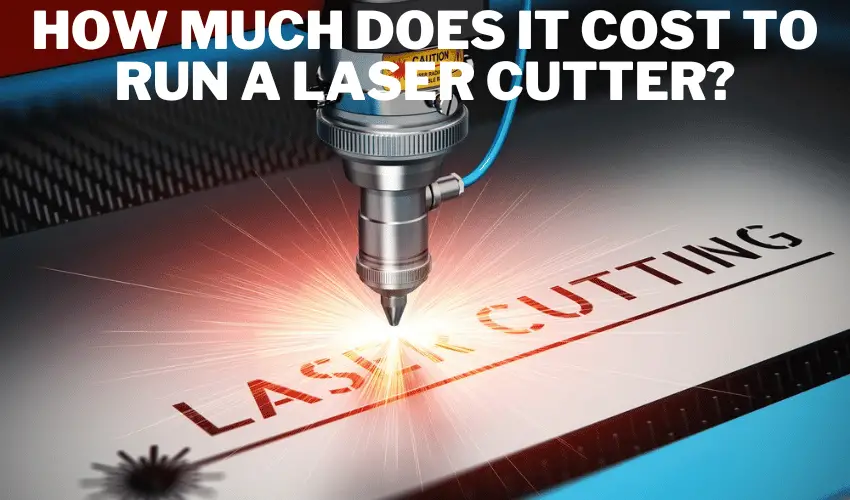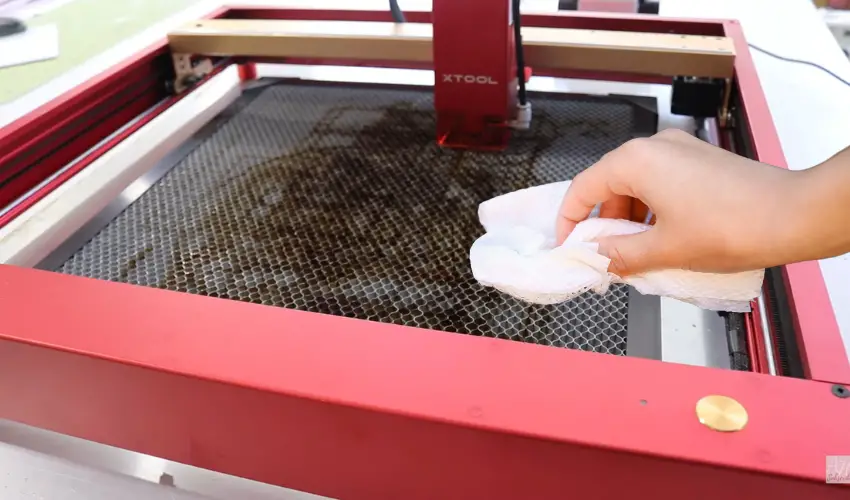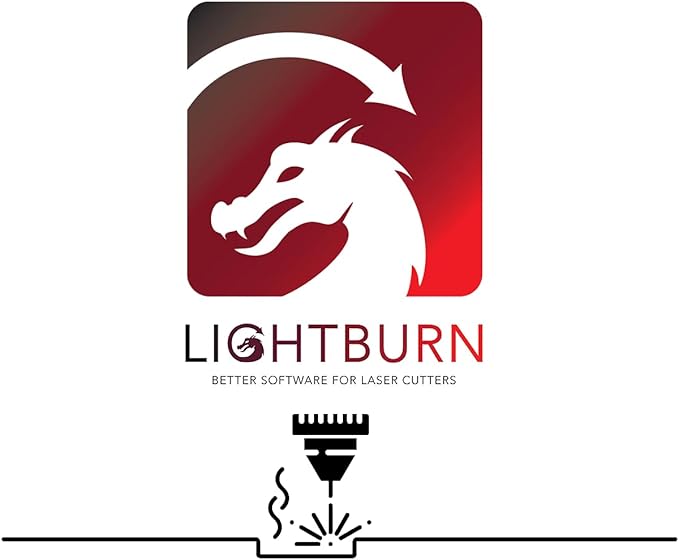Laser cutters are amazing tools for DIYers, makers, and small businesses—but beyond the upfront price tag, how much does it actually cost to run one? Whether you own a diode laser, a CO₂ machine, or a fiber laser, understanding the ongoing expenses can help you plan better, price your products accurately, and avoid unexpected costs.
In this complete guide, we’ll break down the real costs of operating a laser cutter—covering electricity, maintenance, materials, and more.
Table of Contents
Cost to Run a Laser Cutter

Electricity Costs
The electricity cost to run a laser cutter is generally low, but it varies by laser type and wattage.
Laser Type | Wattage Range | Power Consumption per Hour | Estimated Cost/Hour (at $0.13/kWh) |
|---|---|---|---|
Diode Laser | 5W – 20W | 30W – 120W | $0.004 – $0.016 |
CO₂ Laser | 40W – 100W | 200W – 1,000W+ | $0.026 – $0.13+ |
Fiber Laser | 20W – 100W+ | 300W – 2,000W | $0.04 – $0.26+ |
Cost Examples (Per Hour)
- xTool M1 (10W diode): ~60W power draw → ~$0.008/hr
- Glowforge Basic (40W CO₂): ~350W draw → ~$0.045/hr
- xTool P2 (55W CO₂): ~800W draw → ~$0.10/hr
- OMTech 100W CO₂: ~1,000W+ → ~$0.13/hr
- 20W Fiber Laser (industrial): ~600W → ~$0.078/hr
Monthly Electricity Cost Estimate
For a hobbyist running a diode laser 20 hours/month:
60W × 20 hrs = 1.2 kWh → ~$0.15/month
For a small business using a 60W CO₂ laser 80 hours/month:
600W × 80 hrs = 48 kWh → ~$6.24/month
Even with frequent use, electricity is one of the lowest operating costs for laser cutting.
Pro Tip:
Higher-powered machines don’t always consume full wattage 100% of the time, especially during engraving jobs at lower speeds and power settings. Actual consumption can be lower than peak ratings.
Material Costs
Laser cutter material costs can vary widely based on the type, quality, thickness, and size of the material. Below is a helpful breakdown.
Common Laser Cutting Materials & Their Price Range (USD)
Material | Typical Size | Avg. Cost per Sheet | Notes |
|---|---|---|---|
Baltic Birch Plywood (1/8″) | 12″ x 19″ | $2 – $5 | Great for crafts, signs, boxes |
Basswood (1/8″) | 12″ x 19″ | $2.50 – $6 | Good for models, engraving |
MDF (1/8″) | 12″ x 19″ | $1 – $3 | Affordable, good for prototyping |
Acrylic (1/8″) | 12″ x 19″ | $4 – $12 | Available in many colors & finishes |
Clear Acrylic (1/4″) | 12″ x 19″ | $8 – $15 | Thicker and more durable |
Cardboard | 12″ x 19″ | Free – $1 | Great for testing cuts, templates |
Leather (Veg-tan, 5oz) | 12″ x 12″ | $8 – $15 | Real leather is more expensive |
Faux Leather / PU | 12″ x 12″ | $2 – $5 | Cheaper alternative for tags, patches |
Anodized Aluminum Tags | 1.5″ x 3″ (bulk) | ~$0.30 each | Used with fiber/diode lasers |
Slate Coasters | 4″ x 4″ | $1 – $2 | Great for engraving gifts |
Use the code LASERENGRAVINGTIPS for 5% off the best materials for laser engraving & cutting available from Longer Laser Engravers! Click here to check them out!
Cost Tips
- Bulk packs of wood and acrylic from Amazon, xTool, or Johnson Plastics save 15–30%.
- Local hardware stores can cut large sheets into laser bed sizes (cheaper than pre-cut).
- Scrap wood or offcuts from cabinet shops can often be sourced for free or low cost.
- Some crafters use Amazon Basics or Dollar Tree items (e.g., wood blanks, leather notebooks) for affordable engraving projects.
Example Project Material Costs
Project | Material | Approx. Cost |
|---|---|---|
Engraved Keychains (10 pcs) | Faux leather sheet | ~$3–5 |
Custom Sign (12″x19″) | Baltic birch plywood | ~$3 |
Earrings (5 pairs) | Acrylic sheet | ~$4–8 |
Slate Coaster Set (4 pcs) | Slate blanks | ~$5–8 |
Maintenance & Replacement Parts

While laser cutters are generally low-maintenance, regular upkeep and occasional part replacements are crucial for keeping your machine running efficiently.
Routine Maintenance Costs (Per Year)
Item | Frequency | Estimated Cost | Notes |
|---|---|---|---|
Lens and mirror cleaning supplies | Monthly (or more often) | $10–$30 | Alcohol wipes, cotton swabs, lens cleaner |
Lubricants (rails & bearings) | Every 2–3 months | $5–$20 | PTFE/silicone grease |
Air filter replacement (optional) | Every 3–6 months | $60–$150 per filter | For machines with built-in filtration systems |
Laser alignment checkup | Biannually | DIY or ~$50–$100 | Tools often included; pro service optional |
Total Estimated Yearly Maintenance Cost:
$20–$300/year depending on machine type and usage
Common Replacement Parts & Costs
Part | Lifespan | Typical Cost | Applies To |
|---|---|---|---|
CO₂ Laser Tube (40W–60W) | ~1,000–3,000 hours | $150–$400 | CO₂ laser cutters (Glowforge, xTool P2, OMTech) |
Diode Laser Module (5W–40W) | ~5,000–10,000 hours | $100–$300 | Diode laser engravers (xTool M1, S1, Atomstack) |
Focusing Lens | ~6–12 months (heavy use) | $15–$50 | All types |
Mirror Set (CO₂ only) | ~12–24 months | $25–$60 | CO₂ machines only |
Belts and rails | ~1–2 years | $10–$50 | Diode/CO₂ machines |
Cooling fan/air assist fan | ~1–2 years | $15–$80 | Diode & CO₂ lasers |
Honeycomb tray | 1–2 years (wear-based) | $30–$100 | Especially CO₂ |
Air Assist Kit (optional upgrade) | One-time | $60–$150 | Improves cut quality, reduces flare-ups |
Pro Tip: Laser Tube Lifespan = Run Time Hours
A typical CO₂ tube rated for 2,000 hours can last 1–2 years depending on workload. A fiber or diode laser lasts significantly longer and is often easier/cheaper to replace.
Glowforge-Specific Costs
Glowforge Part | Cost |
|---|---|
Laser tube replacement | ~$500–$800 (must be done by Glowforge) |
Air filter cartridge | ~$250 (Glowforge Air Filter) |
Lens replacements | ~$20–$50 |
Glowforge does not offer user-serviceable parts. All replacements go through official service channels.
How to Save on Maintenance
- Clean your optics regularly to avoid beam loss.
- Install an air assist to reduce soot and prolong lens life.
- Use quality materials to avoid extra wear and fouling.
- Avoid overdriving your laser—it reduces lifespan dramatically.
Software Costs

The software you use to run your laser cutter plays a critical role in project design, job control, and efficiency. Some machines include proprietary software, while others require or support third-party apps.
Popular Laser Software & Costs
Software | Cost | Features | Best For |
|---|---|---|---|
xTool Creative Space | Free | Design, engrave, cut, photo engrave, auto settings | xTool machines (M1, P2, S1) |
Glowforge App | Free (Basic) / $50–$240/year (Premium) | Cloud-based design interface, drag/drop, shape tools, design library | Glowforge Basic, Plus, Pro, Aura |
LightBurn | $60–$120 (one-time) + optional $30/year updates | Advanced controls, vector tools, raster/photo support, camera alignment | Diode, CO₂, and galvo lasers |
LaserGRBL | Free | Lightweight G-code sender for GRBL-based lasers | Budget diode lasers (e.g. Ortur) |
RDWorks / LaserWorks | Free (comes with machine) | Basic job control, vector editing | Some CO₂ lasers (e.g. OMTech) |
Adobe Illustrator / CorelDRAW | $20–$55/month | Professional design software (requires export to laser software) | Graphic design + laser workflows |
Inkscape | Free | Open-source vector editor, SVG format support | Budget design + laser setup |
Additional Tools & Plugins
Tool/Plugin | Cost | Purpose |
|---|---|---|
LightBurn Camera | ~$80–$120 | Adds camera preview for design alignment |
AI Image Trace / Raster plugins | Usually free or built-in | Convert images/photos into engravable vectors |
Cloud-based design libraries | Often in subscriptions | Access to SVGs, templates, materials settings |
Tips for Saving on Software
- Use Inkscape + LaserGRBL for a completely free setup (for GRBL/diode lasers).
- Buy LightBurn once—updates are optional after the first year.
- Stick to xTool Creative Space if you use xTool—it’s free and always improving.
- Skip Glowforge Premium unless you need its design assets or shape builder regularly.
Ventilation & Air Purification

Basic Ventilation Setup (Window Exhaust)
Best for: Diode and entry-level CO₂ lasers
Cost Range: $0 – $50
Item | Estimated Cost | Details |
|---|---|---|
Flexible exhaust hose | $0–$30 | Often included with machines (e.g. Glowforge, xTool P2) |
Window vent adapter kit | $10–$30 | Helps seal around the hose to prevent fumes from leaking |
Duct clamps/tape | $5–$10 | For securing hoses to ports or windows |
Pros: Inexpensive, effective for low-volume use
Cons: Not ideal for spaces without nearby windows or in poor weather
Inline Fans / Booster Fans
Best for: Improving fume extraction through long duct runs
Cost Range: $60 – $200+
Item | Estimated Cost | Details |
|---|---|---|
Inline duct fan | $60–$150 | 4–6″ fans rated for 200+ CFM (Vivosun, AC Infinity, etc.) |
Speed controller | $15–$25 | Allows fan speed adjustment |
Hose silencers | $20–$40 | Reduces noise if working in a shared space |
Pros: Quieter, more powerful exhaust
Cons: Requires proper duct routing and power outlet
Air Purifiers / Filtration Systems
Best for: Indoors with no window access or professional setups
Cost Range: $300 – $1,500+
System | Estimated Cost | Details |
|---|---|---|
Glowforge Compact Filter | $995 | Designed specifically for Glowforge models |
xTool Smoke Purifier Box | $399–$699 | Available for xTool P2, M1, S1 |
BOFA AD350 or Fume Extractor | $900–$1,500+ | Industrial-grade air filtration with multi-stage filters |
Replacement filters | $30–$250+ each | Must be replaced periodically depending on use and material types |
Pros: Allows laser use in enclosed spaces
Cons: Expensive upfront + ongoing filter replacement costs
Optional Add-ons
Item | Cost | Use |
|---|---|---|
Air Assist pump | $60–$150 | Helps keep cuts clean, reduces smoke buildup |
Activated carbon sheets | $20–$40 | Extra layer for odor reduction |
Smoke detector/fire alarm | $15–$40 | Recommended safety accessory |
Summary of Ventilation Costs by Setup
Setup Type | Approx. Total Cost |
|---|---|
Basic window exhaust | $0 – $50 |
Inline fan setup | $100 – $250 |
Entry-level purifier (xTool) | $399 – $699 |
Professional filtration system | $900 – $1,500+ |
Accessories & Add-Ons
Over time, you may invest in upgrades like:
- Rotary attachments for engraving tumblers or mugs: $100 – $300
- Riser bases for larger objects: $50 – $150
- Air assist kits to improve cutting quality: $30 – $100
- Material hold-down pins, honeycomb beds, lens upgrades: $10 – $100+
These aren’t essential to run the machine, but they can improve results and productivity.
Hidden Costs to Consider
- Shipping for large materials can be expensive if not sourced locally.
- Trial and error materials wasted during testing.
- Downtime from maintenance or repairs.
- Protective gear like laser safety glasses (for open diode systems).
Real-World Monthly Cost Example
Let’s say you run a hobby diode laser 20 hours per month, using $50 of material and replacing parts once or twice a year.
Item | Monthly Estimate (USD) |
|---|---|
Electricity | $1 – $2 |
Materials | $50 |
Maintenance & supplies | $5 – $10 |
Software | $0 (Free) or $5 (avg.) |
Total | $56 – $67 per month |
For a small business CO₂ laser, running 80+ hours a month, costs could easily be $150–$300/month, depending on usage, filtration, and materials.
Frequently Asked Questions
How much electricity does a laser cutter use?
Electricity costs depend on your laser cutter’s wattage and usage time. On average:
Diode lasers (5W–20W) use about 60–150 watts per hour, costing just a few cents per hour.
CO₂ lasers (40W–100W+) use 300–1,500 watts per hour, costing $0.10 to $0.30/hour, depending on your local electricity rates.
Tip: Add the power usage of accessories like air assist, inline fans, and computers to estimate total power cost.
What materials can I expect to spend the most on?
Material costs vary based on the type and thickness of the material:
Acrylic sheets: $3–$10+ per piece
Wood (basswood, plywood): $2–$15 per sheet
Leather: $5–$25 per piece
Metal (for fiber lasers): $2–$20+
Cardboard/paper: very low cost or even free
Buying in bulk or from wholesale suppliers can significantly reduce your per-project material cost.
Are there any ongoing maintenance or replacement part costs?
Yes, all laser cutters require regular maintenance:
Lens and mirror cleaning: $5–$10 per month in wipes/solutions
Replacement parts (belts, lenses, fans): $10–$100+
Laser tube or diode replacement:
Diode: $50–$150 every 2–3 years
CO₂: $200–$500+ every 1–2 years (depending on usage)
Preventative maintenance reduces long-term costs and extends machine life.
Do I need to pay for laser software?
xTool Creative Space, LightBurn Trial, LaserGRBL: Free or included
LightBurn (popular for CO₂/diode lasers): One-time license of ~$60–$120 depending on license type
Glowforge App: Free version available, but Premium plan is $50–$240/year for advanced features
Most hobbyists use free or low-cost software unless they require pro-level features.
How much should I budget for ventilation or air filtration?
Basic window vent kit: $0–$50
Inline exhaust fan setup: $100–$250
Air purifier or fume extractor (for indoor use):
Consumer-grade: $300–$700
Industrial-grade: $1,000–$1,500+
Replacement filters: $30–$200 every few months (depending on usage)
Proper fume management is essential for safety, especially in enclosed spaces.
Final Thoughts: Is It Expensive to Run a Laser Cutter?
No—not compared to most manufacturing tools. Operating a laser cutter is relatively affordable, especially when you factor in the ability to make high-value products from inexpensive materials. The real costs depend on:
- Laser type and power
- Usage frequency
- Project complexity
- Material choice
- Ventilation needs
Whether you’re engraving gifts or launching a small business, keeping these ongoing costs in mind will help you make smarter purchasing and pricing decisions.
